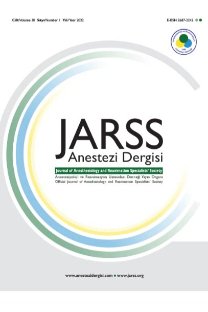Vajinal histerektomilerde intratekal bupivakainin, izobarik ve/veya hiperbarik formlarının karşılaştırılması*
A comparison of intrathecal bupivacaine, isobaric, hyberbaric and/or isobaric forms in vaginal hysterectomy
___
- 1.Lee JJ, Hwang SM, Lee JS, Hong SJ, Lee SK, Lim SY. Continuous infusion of two doses of remifentanil immediately after laparoscopic assisted vaginal hysterectomy. Korean Anestesiol 2010; 58: 537-541.
- 2. Callesen T, Schouenborg L, Nielsen D, Guldager H, Kehlet H. Combined epidural-spinal opioid-free anaesthesia and analgesia for hysterectomy. Br J Anaesth 1999; 82: 881-885.
- 3. Lauretti GR, De Oliveira R, Reis MP, Juliao MC, Pereira NL. Study of three different doses of epidural neostigmine coadministered with lidocaine for postoperative analgesia. Anesthesiology 1999; 90: 1534-1538.
- 4. Lauretti GR, Hood DD, Eisenach JC, Pfeifer BL. A multi-center study of intrathecal neostigmine for analgesia following vaginal hysterectomy. Anesthesiology 1998; 89: 913-918.
- 5. Almeida RA, Lauretti GR, Mattos AL. Antinociceptive effect of low-dose intrathecal neostigmine combined with intrathecal morphine following gynecologic surgery. Anesthesiology 2003; 98: 495-498.
- 6. Davies P, French GW. A randomised trial comparing 5 mL/kg and 10 mL/kg of pentastarch as a volume preload before spinal anaesthesia for elective caesarean section. Int J Obstet Anesth 2006; 15: 279-283.
- 7. Rebel A, Sloan P, Andrykowski M. Retrospective analysis of high dose intrathecal morphine for analgesia after pelvic surgery. Pain Res Manage 2011; 16: 19-26.
- 8. Teo AYH, Goy RWL, Woon YS. Combined spinal-epidural technique for vaginal hysterectomy in a patient with Machado-Joseph Disease. Reg Anesth Pain Med 2004; 29: 352-354.
- 9. Perez J, De Santos P, Plaza A, Mecrada J. Adjuvant methadone or fentanyl in spinal anesthesia with bupivacaine: a randomized, double-blind, placebo-controlled trial. Rev Esp Anestesiol Reanim 2010; 57: 554-552.
- 10. Tsen LC. Anesthesia for cesarean delivery. In: Chestnuts Obstetric Anesthesia Principals and Practice 2009; 521-576.
- 11. Kazak Z, Yılmaz AA, Ozgencil E, Tınaz Döner E, Ökten F, Demiralp S. Major ortopedik cerrahi için spinal anestezide izobarik ve hiperbarik ropivakain ve bupivakainin karşılaştırılması. Anestezi Dergisi 2010; 18: 74-80.
- 12. Kaya Z, Süren M, Erkorkmaz Ü. Arıcı S, Karaman S, Tapar H. Artroskopik diz cerrahisinde tek tarafl spinal anestezide izobarik bupivakain ve izobarik levobupivakainin retrospektif karşılaşrılması. Anestezi Dergisi 2011; 19: 217-223.
- 13. Hotaman L, Türker G, Gurbet A, Yılmazlar T, Bayrak G, Özbey T. Efldeğer dozdaki izobarik levobupivakainin farkl volümlerinin spinal anestezi karakteristikleri üzerine etkileri. Anestezi Dergisi 2010; 18: 29-35.
- 14. Günaydın B, Güngör I, Izdeş S. Final baricity of ropivacaine or bupivacaine combined with fentanyl for intrathecal administration. Turk J Med Sci 2012; 42: 942-945.
- 15. McLeod GA. Density of spinal anaesthetic solutions of bupivacaine, levobupivacaine, and ropivacaine with and without dextrose. Br J Anaesth 2004; 92: 547-551.
- 16. Lui AC, Polis TZ, Cicutti NJ. Densities of cerebrospinal fluid and spinal anaesthetic solutions in surgical patients at body temperature. Can J Anaesth 1998; 45: 297-303.
- ISSN: 1300-0578
- Yayın Aralığı: 4
- Başlangıç: 1993
- Yayıncı: Betül Kartal
Z. Özlem ULUBAY, Banu AYHAN, Meral KANBAK, Bilge ÇELEBİOĞLU, Ülkü AYPAR
Konjenital afibrinojenemili olguda akut batın nedeniyle anestezi deneyimimiz
N. Ferah DÖNMEZ, Oya KILCI, Canan ÜN, Derya TÜRKASLAN, Tolga BARUT, Bayazıt DİKMEN
Transkateter aortik kapak implantasyonu: bir umut mudur?
Tuba YENİAYDOĞMUŞ, Gürkan TÜRKER, Aysun YILMAZLAR
Duchenne musküler distrofili olguda total intravenöz anestezi -tek, düşük doz rokuronyum kullanımı
AHMET CEMİL İSBİR, Cevdet DÜGER, İclal KOL ÖZDEMİR, Kenan KAYGUSUZ, Sinan GÜRSOY, Caner MİMAROĞLU
Hale UYSAL YARKAN, H. Volkan ACAR, Esma TEZER, Ayşegül CEYHAN, Bayazıt DİKMEN
Non-kardiyak cerrahilerin anestezi yönetiminde perioperatif transtorasik ekokardiografi
Berrin GÜNAYDIN, Ece TAN DUMANLAR, Hülya ÇELEBİ
Transkateter aortik kapak implantasyonu ve anestezi
